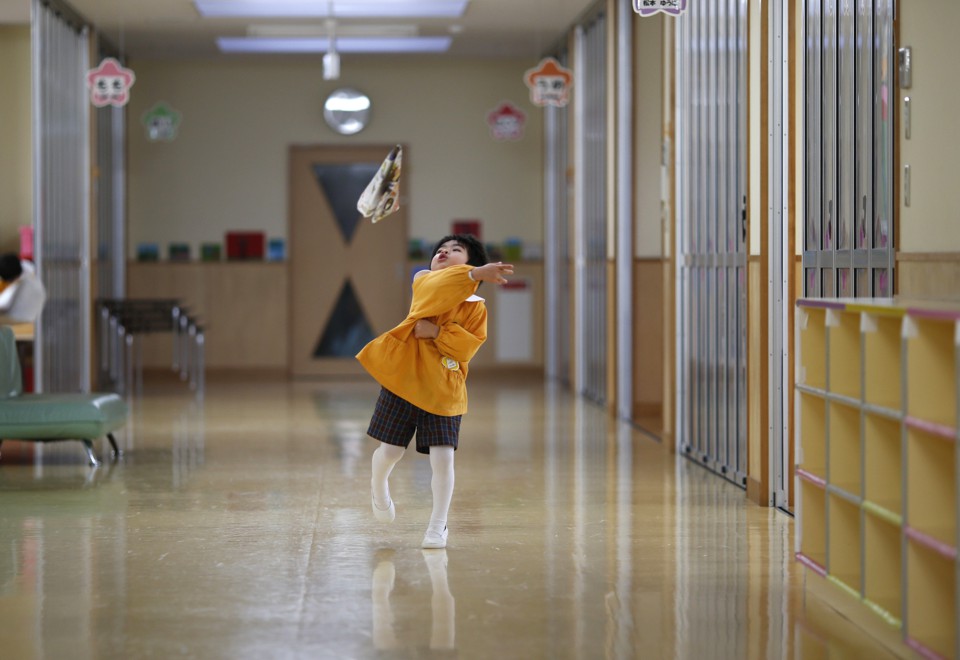
KAWAMATA, Japan—In many countries, the United States included, students’ economic backgrounds often determine the quality of the education they receive. Richer students tend to go to schools funded by high property taxes, with top-notch facilities and staff that help them succeed. In districts where poorer students live, students often get shoddy facilities, out-of-date textbooks, and fewer guidance counselors.
Not in Japan. According to the Organization for Economic Co-operation and Development (OECD), a group of 35 wealthy countries, Japan ranks highly among its peers in providing its rich and poor students with equal educational opportunities: The OECD estimates that in Japan only about 9 percent of the variation in student performance is explained by students’ socioeconomic backgrounds. The OECD average is 14 percent, and in the United States, it’s 17 percent. “In Japan, you may have poor areas, but you don’t have poor schools,”
John Mock, an anthropologist at Temple University’s Japan campus, told me.
Perhaps as a result, fewer students in Japan struggle and drop out of school—the country’s high-school graduation rate, at 96.7 percent, is much higher than the OECD average and the high-school graduation rate in the United States, which is 83 percent. Plus, poorer children in Japan are more likely to grow up to be better off in adulthood, compared to those in countries like the U.S. and Britain (though Scandinavian countries lead in this regard). “It’s one of the few [education] systems that does well for almost any student,” Andreas Schleicher, who oversees the OECD’s work on education and skills development, told me, adding, “Disadvantage is really seen as a collective responsibility.”
For instance, in the village of Iitate, which was evacuated after being contaminated by radiation after the Fukushima nuclear-power-plant disaster in March 2011, many families still have not come back. Piles of contaminated soil, covered up, still dot the landscape, and many homes are shuttered. The local primary school has just 51 students, compared to more than 200 before the accident. Yet the quality of education given to returnees is top-notch. The government built a new school for students outside the radiation zone, in a town called Kawamata, and though the classes are still very small—first grade has only two students—the school is well staffed. In a classroom I visited, all five second-graders in the school watched a teacher demonstrate flower-arranging as three other teachers surrounded them, helping them with each step. In another, a math teacher quizzed students on odd and even numbers, and as the students split into groups to discuss a problem on the board, another teacher leaned in to help. Walking around the school, it almost seemed there were as many teachers as students.
“The quality of education is better than before March 11th [2011],” Tomohiro Kawai, a parent of a sixth-grader and the president of the school’s parent-teacher association, told me, citing the low student-teacher ratio. Many of the children who returned to the area are from single-parent families, a group prone to struggling economically; some parents moved back to Iitate because they needed help from their own parents in watching their children, according to Satoko Oowada, one of the school’s teachers. But the federal government takes pains to prevent economic hardship from affecting the quality of students’ education. It gave a grant to Iitate so that all students in the school would get free lunch, school uniforms, notebooks, pencils, and gym clothes. “Equality of education is very important for children in Iitate Village,” the school’s principal, Takehiko Yoshikawa, told me. “Everywhere, students receive the same education.”
The equity in Iitate stands in stark contrast to a place like New Orleans, which was also hit by a disaster. While Japan’s national government tried to ensure that students in the affected area got more resources after the accident, officials in New Orleans disinvested in the public educational system in their city. Public-school teachers were put on leave and dismissed, many students disappearedfrom schools’ rolls, and the New Orleans system now consists almost entirely of charter schools. (To be sure, New Orleans is something of an outlier—districts in New York and New Jersey, for example, received federal money to help deal with Hurricane Sandy’s impact on education.)
There are a number of reasons why Japan excels in providing educational opportunities. One of them is how it assigns teachers to schools. Teachers in Japan are hired not by individual schools, but by prefectures, which are roughly analogous to states. Their school assignments within the prefecture change every three years or so in the beginning of their careers, and then not quite as often later on in their careers. This means that the prefectural government can make sure the strongest teachers are assigned to the students and schools that need them the most. “There’s a lot going on to redirect the better teachers, and more precious resources, towards the more disadvantaged students,” Schleicher said.
It also means that teachers can learn from different environments. Young teachers are exposed to a series of different talented peers and learn from their methods. That’s a big contrast to some place like the United States, said Akihiko Takahashi, a onetime teacher in Japan and now an associate professor of elementary math at DePaul University’s College of Education. “Here in the U.S., the good teachers go to the good schools and stay there the whole time,” he told me.
[“Source-theatlantic”]
